Arizona is home to 23 venomous snake species. Among these, 17 species are rattlesnakes, known for their distinct rattling warning. The state is also home to the Arizona Coral Snake, a relative of the cobra family, and five rear-fanged venomous snakes, which are less dangerous compared to the other 18 species.
Arizona has an average of 102 snake bites reported annually. Understanding these snakes and their habitats is crucial for outdoor safety.
We’ll dive into in-depth profiles of these venomous snakes, focusing on how to identify them and where they are commonly found in Arizona. We will also provide safety tips for avoiding dangerous encounters.
If you enjoy being outdoors, this comprehensive resource on Arizona’s venomous snakes will equip you with the knowledge to stay safe and informed.
Pit Vipers: The Venomous Masters of Infrared Detection
Rattlesnakes, Copperheads, and Cottonmouths are North American members of the Crotalinae subfamily of the Viperidae family of venomous snakes. They are also referred to as pit vipers.
Since there are 17 Arizona rattlesnakes, let’s take a look at some pit viper characteristics.
What Makes Pit Vipers Unique?
- Infrared-Sensing Pits:
A defining feature of pit vipers is the deep facial pit between their nostril and the eye on each side of their head. These specialized infrared-detecting organs allow pit vipers to sense heat emitted by prey. This adaptation enables them to:- Detect body heat from up to 1 meter away.
- Strike prey with pinpoint accuracy, even in complete darkness.
- Triangular Heads and Vertical Pupils:
- Head Shape: Pit vipers are recognized by their distinct triangular-shaped heads, which house their venom glands.
- Eyes: They have vertical elliptical-shaped pupils.
- Venomous Fangs:
Pit vipers have hollow fangs connected to venom glands. These fangs fold back against the roof of their mouth when not in use.
Ecological Importance
Pit vipers serve as a check to rodent populations. Despite their fearsome reputation, these snakes are vital to the health of many habitats.
Rattlesnakes in Arizona
There are 17 rattlesnake species in Arizona. Arizona rattlesnakes have characteristics in common with all pit vipers. However, one characteristic that sets them apart is their rattle.
- Most rattlesnakes have a rattle at their tail’s end, comprised of hollow, loosely interlocked keratinous scales.
- Normally, a rattlesnake adds a new segment to its rattle each time it sheds its skin.
- An agitated rattlesnake rapidly vibrates its tail, causing the segments of its rattle to vibrate together, creating a buzzing or rattling sound.
- If you hear a rattling noise, do not move until you spot where it originated. Otherwise, you may accidentally move into the snake, provoking it to bite you.
- Not all of Arizona’s rattlesnakes rattle before they strike. Sometimes, they lose their rattles due to injury, and sometimes, they choose not to rattle.
- You must pay attention to where you place your feet and hands when you’re in rattlesnake country.
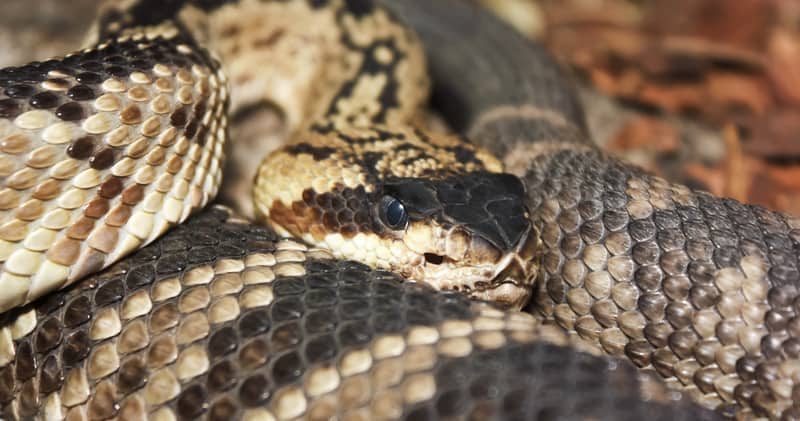
Mojave Rattlesnake (Crotalus scutulatus)
(Other common names are Mojave Green Rattlesnake and Mohave Rattlesnake.)
What Do Mojave Rattlesnakes Look Like?
| Size | *Adults range from 2 to 4 ft (about 0.61 to 1.22 m) in length. |
| Coloration | *A Mojave rattlesnake’s base color varies but is generally tan with a greenish tinge. |
| Dorsal Spots | *Along their backs, they feature a distinctive dark brown diamond-like pattern. |
| Head | *Like all pitvipers, Mojave Rattlesnakes have triangular-shaped heads. *The color varies with the base color of the snake. *A pale stripe extends from behind its eye on a diagonal past the end of its jaw. |
| Tail | *Tails are white and black banded. |
Where Do Mojave Rattlesnakes Live in Arizona?
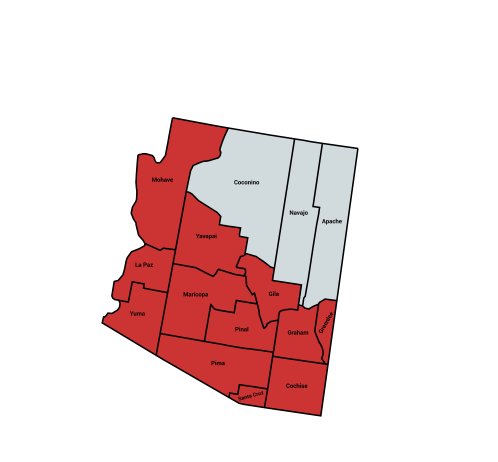
Mojave rattlesnakes range throughout Arizona but are most numerous in the southern and western portions of the state. These snakes prefer desert flats with sparse vegetation or rocky areas.
How Dangerous Are Mojave Rattlesnakes?
The Mojave Rattlesnake has the most toxic venom of all rattlesnakes. They are one of the most dangerous snakes in Arizona.
Their venom is either hemorrhagic/hemotoxic or neurotoxic. The type of venom the snake has depends on the area in which it lives. Their hemorrhagic venom prevents blood clotting and destroys body tissue. On the other hand, their neurotoxic venom is even more dangerous. It shuts down the nervous system. Victims of neurotoxic venom may become paralyzed. Furthermore, they can lose the ability to breathe.
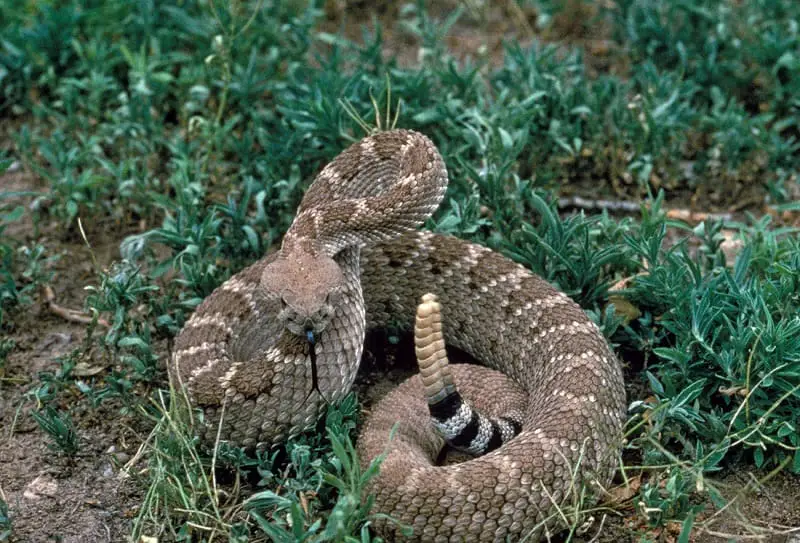
Western Diamondback Rattlesnake (Crotalus atrox)
(Also known as the Western Diamond-backed Rattlesnake or Adobe Snake.)
What Do Western Diamondback Rattlesnakes Look Like?
| Size | Grows from 4 ft to 7 ft (1.22 to 2.13 m) in length. Average weight: 3 to 6 lb (1.23 to 2.7 kg) |
| Coloration | *Base colors: Yellow, light brown, salmon, gray, gray-brown, cream, or olive. *Dark diamond-shaped patterns along the back give it the name “Diamondback.” *A dark line runs from the corner of the mouth to behind the eye. |
| Dorsal spots | *Edges are darker than the base color. *Centers are slightly darker than the base color. |
| Head | *Western Diamondback Rattlesnakes have a triangle shaped head that is characteristic of pitvipers. *The color varies with the base color of the snake. *A pale stripe extends from behind its eye on a diagonal to the end of the upper lip. |
| Tail | *Features two to eight black bands above the rattle which are separated by pale gray bands. |
Where Do Western Diamondbacks Live in Arizona?
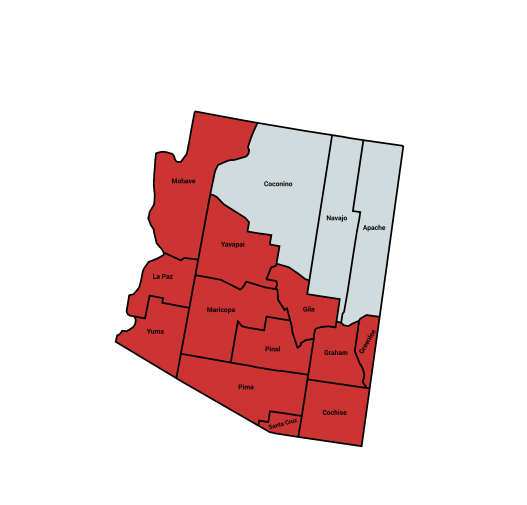
The Western Diamondback rattlesnake’s range in the U.S. begins in Arkansas and Oklahoma. It then stretches to the west and takes in parts of Texas, New Mexico, Arizona, Nevada, Utah, and California.
Western Diamondback rattlesnakes are found in the southern half of Arizona. They range as far north as the rim of the Grand Canyon.
How Dangerous Are Western Diamondback Rattlesnakes?
Western Diamondback rattlesnakes bite more people and cause more human fatalities than any other venomous snake in Arizona.
Their venom is hemotoxic, cytotoxic, and myotoxic. If a Western Diamondback bite goes untreated, it can cause serious problems. These include severe internal bleeding and tissue damage, which might result in gangrene.
Mojave Rattlesnake vs Diamondback
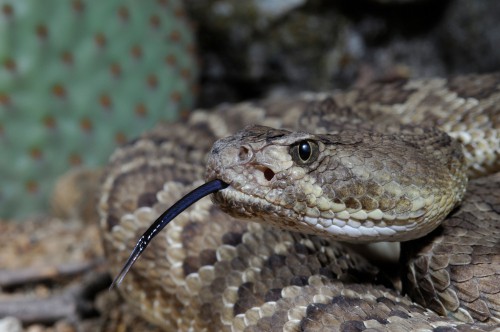
Mojave Rattlesnake
- White bands on the end of the tail are wider than the black bands.
- A pale stripe extends from behind its eye on a diagonal past the end of its jaw.
- Larger scales on top of their head.
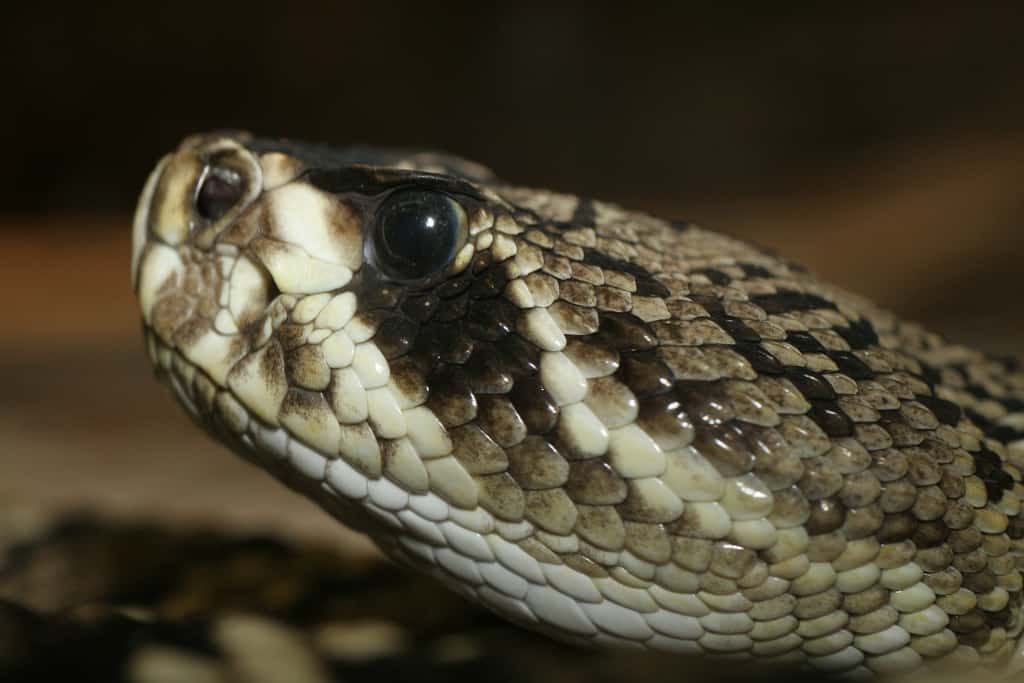
Western Diamondback Rattlesnake
- The black bands on the end of the tail are equally sized to the white bands.
- A pale stripe extends from behind its eye on a diagonal to the end of the upper lip.
- Smaller scales on top of their head.
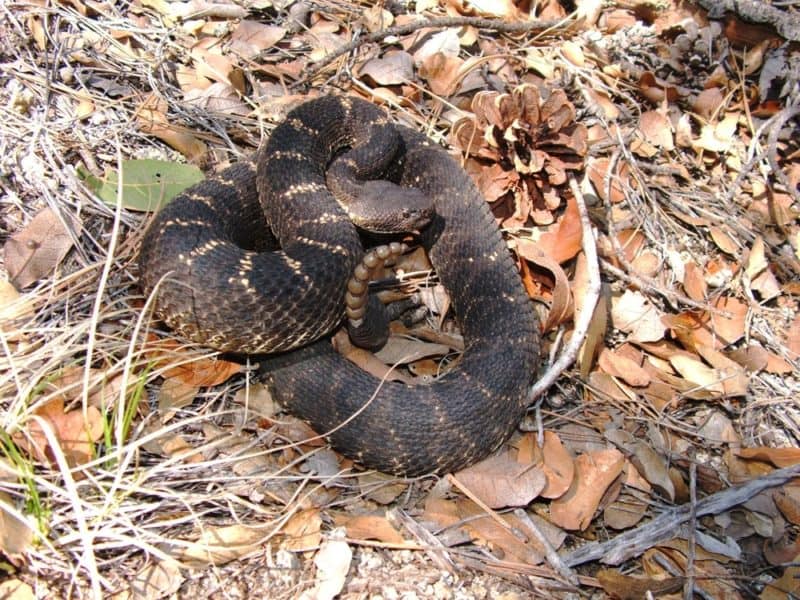
Arizona Black Rattlesnake (Crotalus cerberus)
This species has various common names. They include Black rattlesnake, Black Diamond rattlesnake, and Mountain Diamondback.
What Do Arizona Black Rattlesnakes Look Like?
| Size | *The Arizona Black Rattlesnake is a thick-bodied snake. *Adults typically range from 28 to 48 inches (70 to 121 cm) in length. |
| Coloration | *The base color varies and can be dark gray, reddish brown, or completely black. |
| Dorsal Spots | *Dark blotches run along the back, transitioning into crossbands near the tail. *In some individuals, the dorsal blotches may be darker and outlined with white, cream, or yellow scales. *Alternatively, the snake may appear uniformly dark with no distinct pattern. *Juveniles have more vivid and prominent markings compared to adults. |
| Unique Trait | *This species has a chameleon-like ability to change color, adapting to different surroundings. |
Where Do Arizona Black Rattlesnake Live?

The Arizona Black rattlesnake lives at higher elevations, preferring wooded areas throughout Arizona.
Their territory takes in parts of the following counties:
- Mohave
- Coconino
- Yavapai
- Maricopa
- Gila
- Navajo
- Apache
- Greenlee
- Graham
- Pinal
- Pima
How Dangerous Are Arizona Black Rattlesnakes?
Arizona Black rattlesnake venom is a mix of myotoxins and hemotoxins. Envenomations from this snake are rare. However, severe envenomation can produce pain, edema, blistering, nausea, and vomiting. The venom may also prevent blood coagulation and destroy red blood cells. This can produce shock and internal organ failure, particularly kidney failure.
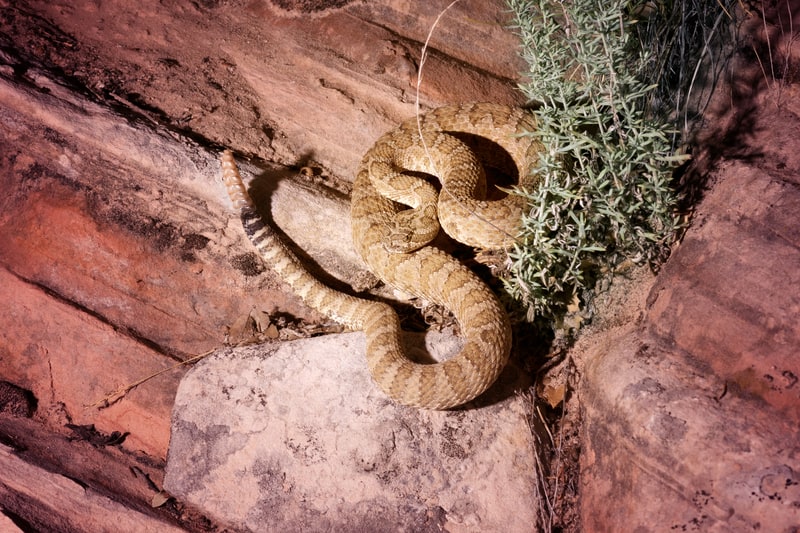
Great Basin Rattlesnake (Crotalus o. lutosus)
The Great Basin rattlesnake is a subspecies of the Western rattlesnake.
What Do Great Basin Rattlesnakes Look Like?
| Size | *Most Great Basin rattlesnakes are under 3 feet (0.91 m) in length. *The largest specimens can reach up to 4 feet (1.22 m). |
| Coloration | *Their bodies are light gray or light brown. |
| Dorsal Spots | *Dark blotches cover their bodies, typically dark brown to black with pale centers. |
Where Do Great Basin Rattlesnakes Live in Arizona?
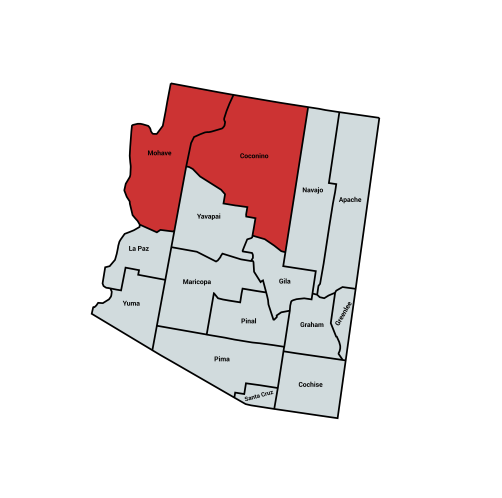
Great Basin rattlesnakes have a variety of habitats in which they can live and survive. These include juniper forests, age-low banks, and rocky outcrops. The Great Basin rattlesnake lives in the Northwestern corner of Arizona, in parts of Mohave and Coconino Counties.
How Dangerous Are Great Basin Rattlesnakes?
Great Basin rattlesnake venom is a potent mix of myotoxins and hemotoxins. Their bites may produce pain, edema, nausea, and vomiting. Furthermore, the hemotoxic part of their venom can cause internal bleeding. This may lead to multiple organ damage. Moreover, the myotoxic part of their venom will produce necrosis of body tissue.
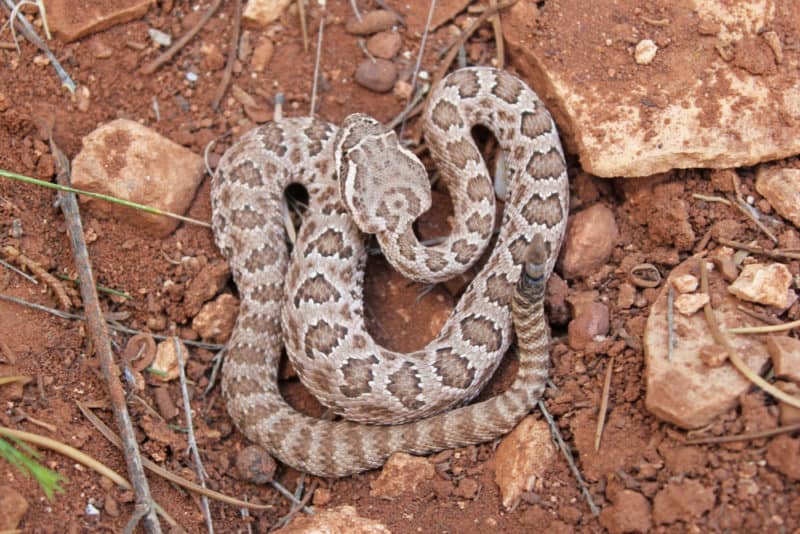
Grand Canyon Rattlesnake (Crotalus o. abyssus)
What Do Grand Canyon Rattlesnakes Look Like?
| Size | *Adults range from 16 to 54 inches (41 to 137 cm) in length. |
| Coloration | *Their base color varies and may be pink, yellowish-green, tan, or gray. |
| Dorsal Spots | *Brown blotches run down their backs, transitioning into bands near the tail. *Younger snakes typically have more prominent markings than adults. *Some adults may have no body markings at all. |
Where Do Grand Canyon Rattlesnakes Live in Arizona?
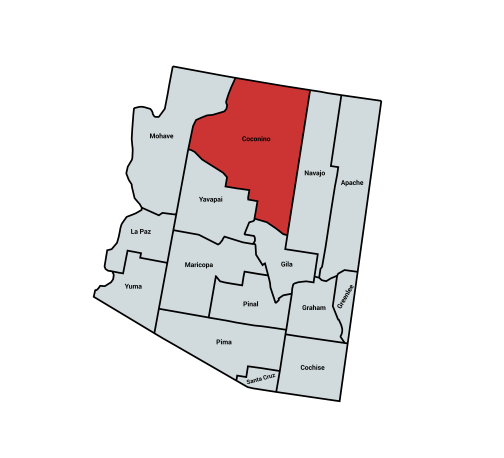
Grand Canyon rattlesnakes live only in North-central Arizona and South-central Utah. In Arizona, they live along both the rims of the Grand Canyon, Paria River Drainages, and the Glen Canyon area. It is a diurnal snake, but it can be active around the clock when conditions are favorable.
How Dangerous Are Grand Canyon Rattlesnakes?
Grand Canyon rattlesnake venom is a potent mix of neurotoxins and hemotoxins. Their bites may produce pain, edema, nausea, and vomiting. Furthermore, the hemotoxic part of their venom can cause internal bleeding. This may lead to multiple organ damage.
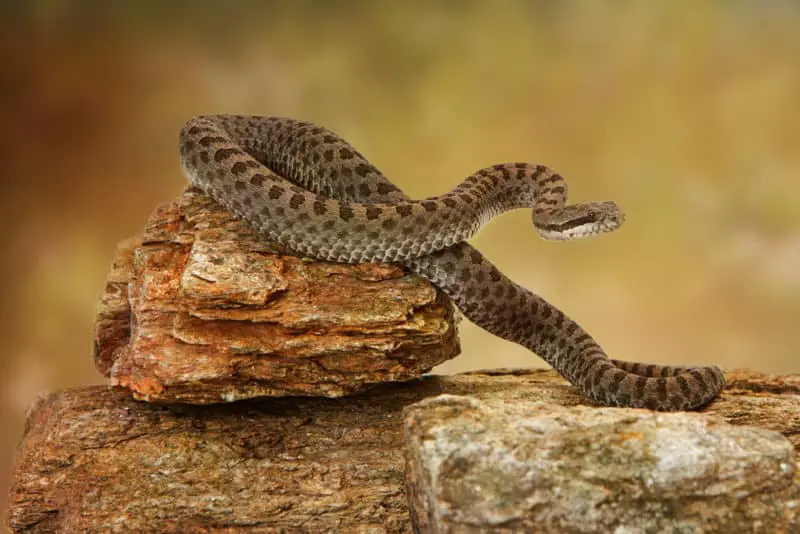
Twin-Spotted Rattlesnake (Crotalus price)
What Do Twin Spotted Rattlesnakes Look Like?
| Size | *Adults are small, measuring 20 to 26 inches (50 to 60 cm) in length. |
| Coloration | *Their base color varies and can be brownish-gray, bluish-gray, or reddish-brown. *Fine brown speckling is often present across their bodies. |
| Dorsal Spots | *They feature a series of dark dorsal spots on top of their base color. *These spots are divided along the spine, forming 39 to 64 pairs. |
Where Do Twin-Spotted Rattlesnakes Live in Arizona?
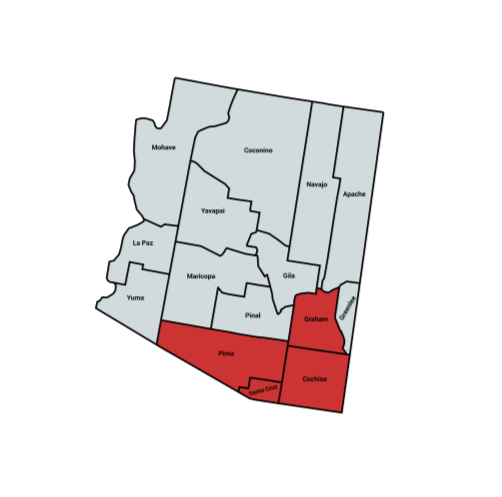
The Twin-Spotted rattlesnake lives in southeastern Arizona, in parts of Cochise, Santa Cruz, Pima and Graham Counties.
How Dangerous Are Twin-Spotted Rattlesnakes?
Twin Spotted rattlesnakes venom is Hemotoxic. A Twin-Spotted rattlesnake bite might cause mild pain, swelling, blistering, nausea, and vomiting. Furthermore, the venom may destroy red blood cells and impair blood coagulation, leading to severe systemic symptoms.
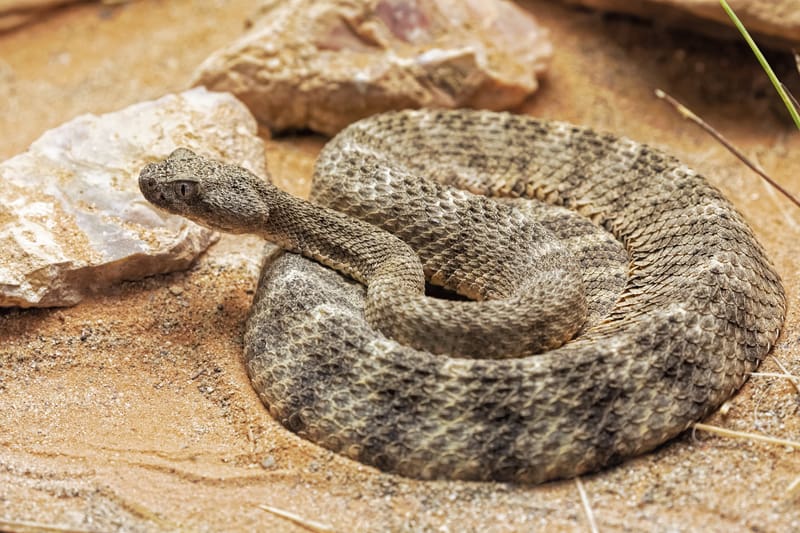
Tiger Rattlesnake (Crotalus tigris)
What Do Tiger Rattlesnakes Look Like?
| Size | *These snakes measure 18 to 36 inches (46 to 91 cm) in length. |
| Coloration | *Their base color varies and can be gray, blue-gray, lavender, pink, or buff. *Cream or pale orange tones are often visible on their sides. |
| Markings | *They have 35 to 52 brown or black crossbands that span their entire body. *Unlike most rattlesnakes, whose crossbands are confined to the tail, Tiger rattlesnakes are the only species with crossbands covering their entire body—this is a key distinguishing feature. |
| Head Shape | *Their head is small and spade-shaped, the smallest of all rattlesnake species. |
| Rattle | *They possess a disproportionately large rattle compared to their body size. |
Where Do Tiger Rattlesnakes Live in Arizona?
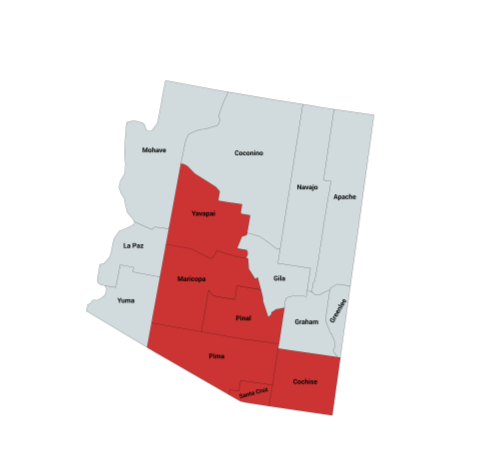
The Tiger Rattlesnake’s home extends from central Arizona south through south-central Arizona. They are found in the following Arizona Counties:
- Cochise
- Yavapai
- Santa Cruz
- Maricopa
- Pima
- Pinal
How Dangerous Are Tiger Rattlesnakes?
The Tiger rattlesnake has one of the most deadly rattlesnake venoms. It is a potent mix of hemotoxins and myotoxins.
This rattlesnake has a low venom yield per bite. But its venom has the second-highest toxicity of all the rattlesnake venoms. It is also the second most potent venom among all snakes in the Western Hemisphere.
There are a few recorded human envenomations by Tiger rattlesnakes. These all produced limited localized pain and swelling. These snakes produce a low venom yield and have small fangs. This possibly prevents adults from developing more severe reactions. However, a child or a smaller adult might have more severe complications. Any bite from a Tiger rattlesnake is a medical emergency. The bitten individual should seek immediate medical attention.
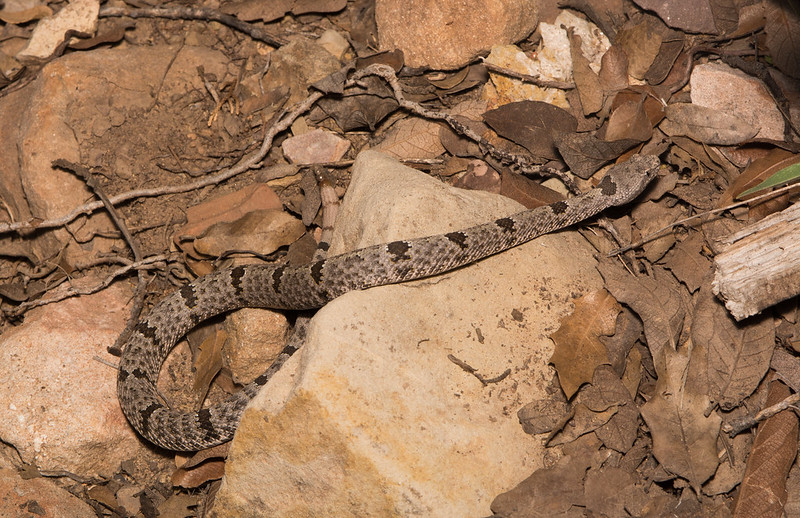
Banded Rock Rattlesnake (Crotalus lepidus klauberi)
What Do Banded Rock Rattlesnakes Look Like?
| Size | *These snakes are small, measuring 24 to 33 inches (61 to 84 cm) in length (excluding the rattle). |
| Coloration | *Their color pattern varies and ranges from bluish-gray to greenish-gray. *A pinkish mottling is sometimes visible on their underside, darkening toward the tail. |
| Dorsal Spots | *They have 14 to 24 dark gray to black jagged crossbands along their back. *Dark spots or flecks are often found between the crossbands. |
| Rattle | *Their rattle is large compared to their overall body size. |
Where Do Banded Rock Rattlesnakes Live in Arizona?
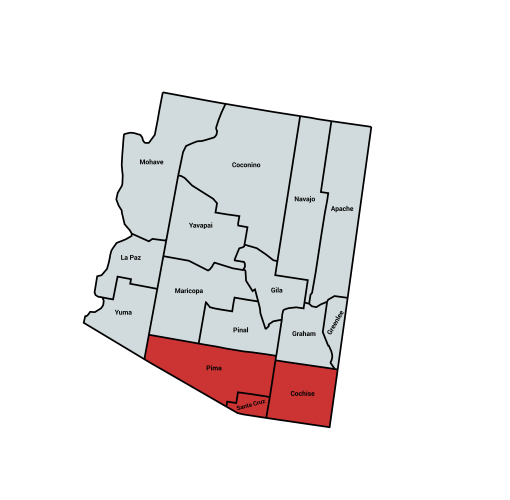
As its name implies, the Banded Rock rattlesnake spends time in rocky terrain. They prefer steep talus slopes, stream beds, and rock outcroppings. They also follow drainages down into the grasslands of South Eastern Arizona. They live in parts of Cochise, Santa Cruz, and Pima Counties in Arizona.
How Dangerous Are Banded Rock Rattlesnakes?
A Banded Rock rattlesnake’s venom is hemotoxic. It can lead to various symptoms. It can cause significant pain and swelling at the bite site, making it uncomfortable. Nausea and vomiting might also occur. It can affect blood clotting and lead to excessive bleeding. It may also induce shock, leaving the victim feeling weak and disoriented. There’s also a possibility of mild paralysis. It’s crucial to seek immediate medical help if bitten by a Banded Rock rattlesnake.
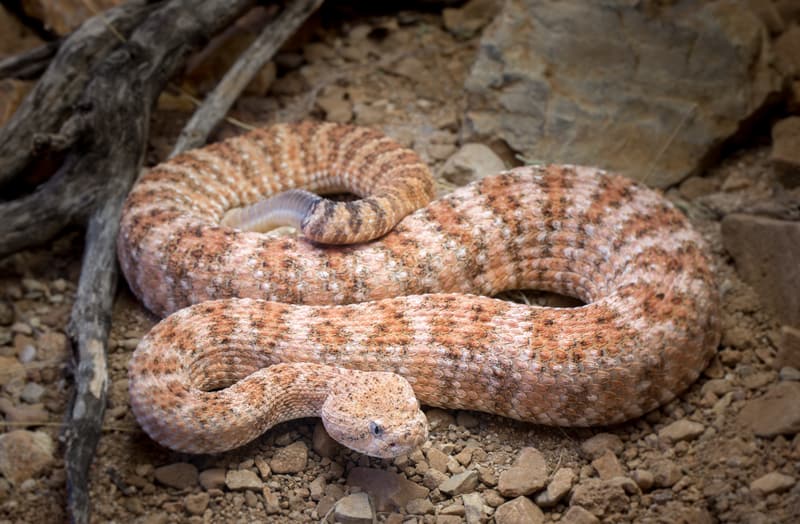
Southwestern Speckled Rattlesnake (Crotalus pyrrhus)
Other common names for this snake include Mitchell’s rattlesnake and White rattlesnake.
What Do Southwestern Speckled Rattlesnakes Look Like?
| Size | *These snakes can grow up to 39 inches (100 cm) in length. |
| Coloration | *Their color varies and includes cream, tan, gray, bluish-gray, orange, or yellowish-pink. |
| Dorsal Spots | *Their speckled appearance comes from the unique pattern of their scales. *They have two black bands just above the rattle. |
Where Do Southwestern Speckled Rattlesnakes Live in Arizona?
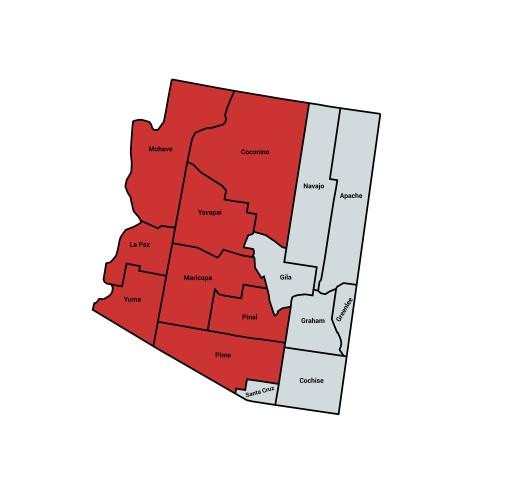
The Speckled rattlesnake ranges throughout the state of Arizona. They prefer rocky terrain with some vegetation. In Arizona, they live in parts of the following Counties. Coconino, Maricopa, Mohave, La Paz, Yuma, Pima, Pinal and Yavapai Counties.
How Dangerous Are Southwestern Speckled Rattlesnakes?
A Speckled rattlesnake’s venom is hemotoxic. It can lead to various symptoms. It can cause significant pain and swelling at the bite site, making it uncomfortable. Nausea and vomiting might also occur. It can affect blood clotting and lead to excessive bleeding. It may induce shock, leaving the victim feeling weak and disoriented. There’s also a possibility of mild paralysis. It’s crucial to seek immediate medical help if bitten by a Speckled rattlesnake.
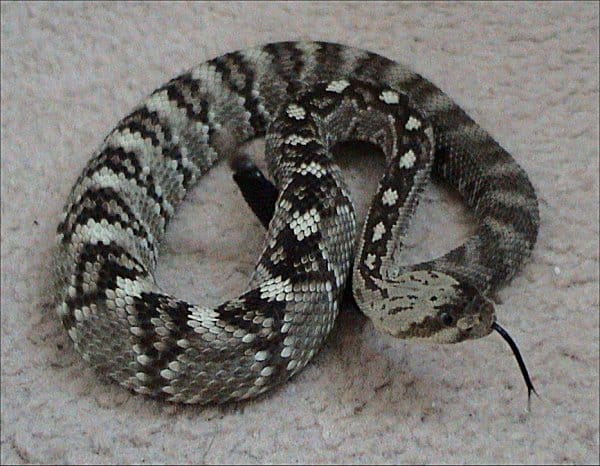
Northern Blacktail Rattlesnake (Crotalus molossus)
What Do Northern Blacktail Rattlesnakes Look Like?
| Size | *They measure 30 to 42 inches (76.2 to 106.48 cm) in length. *Males are generally smaller than females. |
| Coloration | *Their base color varies and can be yellow, olive green, or gray. |
| Dorsal Spots | *Dark blotches with white borders are present on their bodies. |
| Head | *A black “mask” band runs across their eyes, extending diagonally to the corners of their mouth. |
| Tail | *Their most distinctive feature is their black tail, which contrasts with their body color. |
Where Do Northern Blacktail Rattlesnakes Live in Arizona?
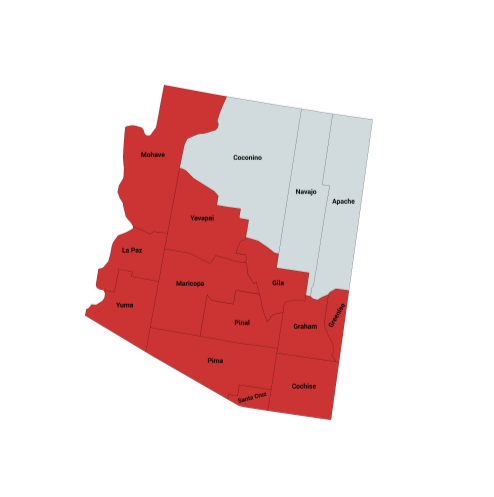
Northern Blacktail Rattlesnakes live in mountainous areas and are found everywhere in Arizona, south of the Grand Canyon.
How Dangerous Are Northern Blacktail Rattlesnakes?
The venom of the Northern Blacktail Rattlesnake is hemotoxic. However, it is less toxic than the venom of some other rattlesnakes. For example, it is only two-thirds as toxic as the venom of the Western Diamondback. In general, it is not fatal to humans. They have larger venom glands than most rattlesnakes in the area. Because their venom is less toxic, they need to inject a large quantity into their prey to be effective.
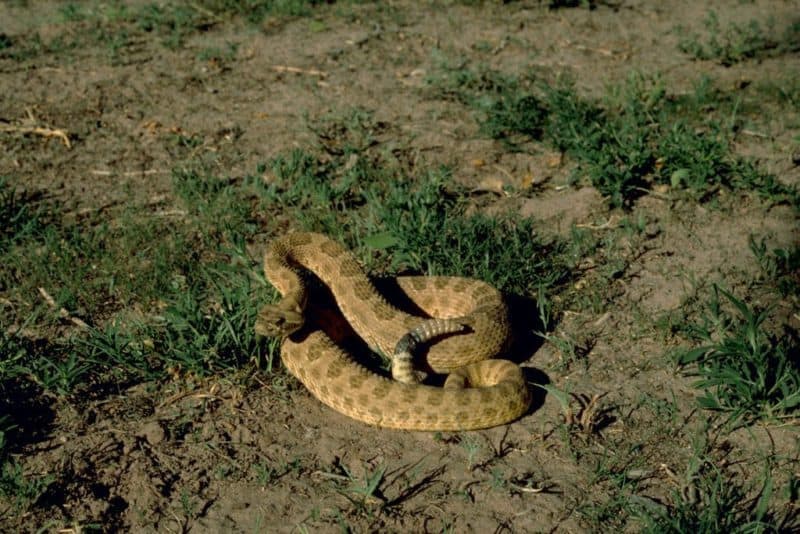
Prairie Rattlesnake (Crotalus viridis)
What Do Prairie Rattlesnakes Look Like?
| Size | *Adults typically measure about 3.3 feet (100 cm) in length. *The longest recorded specimen was just under 5 feet (151.5 cm) long. |
| Coloration | *Their base color varies and can be tan, olive green, or brown. |
| Dorsal Spots | *Brown blotches with darker borders are present on their bodies. |
| Head | *They have a triangular-shaped head with pit sensory organs on either side. *A light stripe runs diagonally from the back of each eye to the jaw. *Another stripe extends diagonally from below the eye to the corner of the mouth |
| Behavior | *Primarily ground-dwelling but occasionally climbs shrubs, bushes, or trees. |
Where Do Prairie Rattlesnakes Live in Arizona?
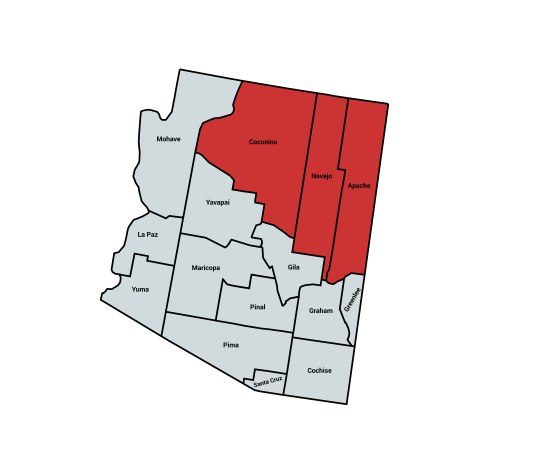
In Arizona, they are found in the Northeastern corner of the state. They live in Apache, Navajo, and Coconino Counties.
How Dangerous Are Prairie Rattlesnakes?
Prairie rattlesnake venom is a mix of hemotoxins and myotoxins. Furthermore, according to some literature, it also has neurotoxins.
Prairie rattlesnake bites can have serious effects. The venom can cause severe pain. It may also induce shock, making the victim feel weak and disoriented. Swelling, blistering, and inflammation can occur at the bite site. Their venom can also damage red blood cells and impair blood clotting. In severe cases, the bite may result in severe tissue damage. There is also a risk of harm to internal organs.

Hopi Rattlesnake (Crotalus viridis nuntius)
Other common names for this snake include Arizona Prairie Rattlesnake and Prairie Rattlesnake.
What Do Hopi Rattlesnakes Look Like?
| Size | *Hopi rattlesnakes are a smaller subspecies of the Prairie Rattlesnake. *Adults grow up to 2 feet long (60cm). |
| Coloration | *Their body color varies with their natural surroundings. *Generally pinkish brown to tan. |
| Dorsal spots | *Brown blotches with darker borders are present on their bodies. |
| Behavior | *Primarily ground-dwelling, but occasionally climb shrubs, bushes, or trees. |
Where Do Hopi Rattlesnakes Live in Arizona?
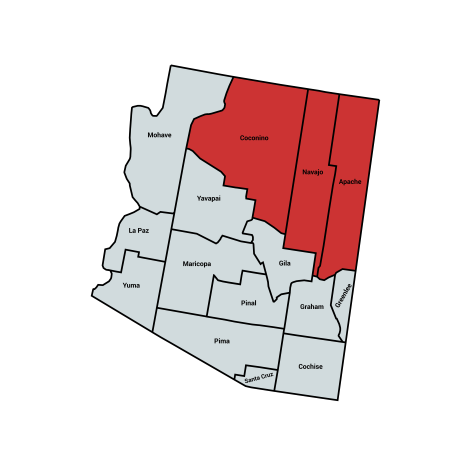
The Hopi rattlesnake is found in northeast Arizona at elevations of 4501–7001 feet. They also live in Utah and New Mexico.
How Dangerous Are Hopi Rattlesnakes?
Their venom is both hemotoxic and neurotoxic.
Hopi rattlesnake bites can have serious effects. The venom can cause excruciating pain. It may also induce shock, making the victim feel weak and disoriented. Swelling, blistering, and inflammation can occur at the bite site. Nausea and vomiting may follow. Their venom can also damage red blood cells and impair blood clotting. In severe cases, the bite may result in severe tissue damage. There is also a risk of harm to internal organs. This makes a Hopi rattlesnake bite a dangerous and potentially life-threatening situation.
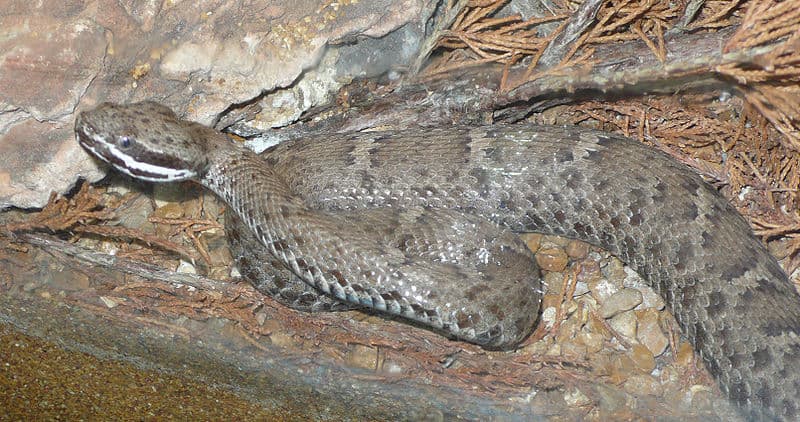
Ridgenosed Rattlesnake (Crotalus willardi)
The Ridgenosed rattlesnake is the official state reptile of Arizona.
What Do Ridgenosed Rattlesnakes Look Like?
| Size | *This rattlesnake is rather small. *Adults grow between 12 to 24 inches (30 to 60 cm) long. |
| Coloration | *Dark brown base color.with white horizontal striping. |
| Dorsal Spots | *White to cream horizontal striping. |
| Nose | *The ridges along each side of its nose are unique to this rattlesnake and are why they are named “Ridge-nosed.” |
Where Do Ridgenosed Rattlesnakes Live in Arizona?
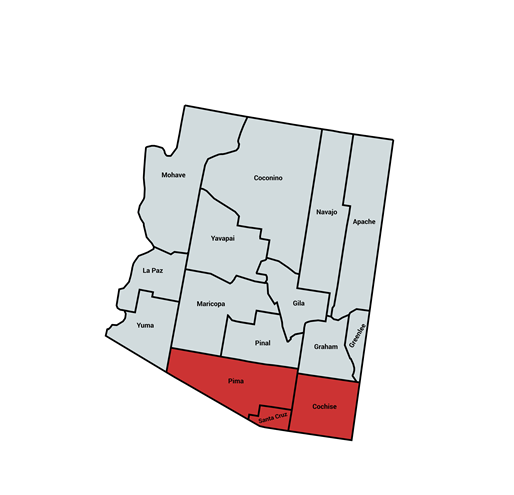
Ridgenosed rattlesnakes live in mountainous areas at elevations above 4,000 feet. The wooded “Sky Island” ranges of Southeast Arizona are within their range.
How Dangerous Are Ridgenosed Rattlesnakes?
Ridgenosed rattlesnakes have hemotoxic venom. However, their venom yield per bite is low. Consequently, their bites are usually not as life-threatening. Ridge-nosed bites result in edema and discomfort. However, there are no documented deaths caused by this snake.
We’ve established that Arizona Ridge-nosed rattlesnakes are relatively harmless. Even so, any bite from one of these snakes is still a medical emergency. If you are bitten by one, you must seek prompt medical attention.
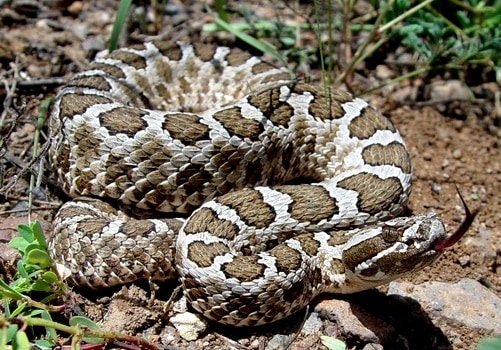
Desert Massasauga Rattlesnake (Sistrurus catenatus edwardsii)
What Do Desert Massasauga Rattlesnakes Look Like?
| Size | *Adults range from 24 to 30 inches (61cm to 76cm) long. |
| Coloration | *Their base color is either tan or gray. *Younger snakes are paler than adults. |
| Dorsal Spots | *A row of large, rounded, blackish-brown spots run down their spine. *They have three smaller rows of spots down each side. *In some cases, the larger dorsal spots connect with the side spots, forming a large solid blotch. |
Where Do Desert Massasauga Rattlesnakes Live in Arizona?
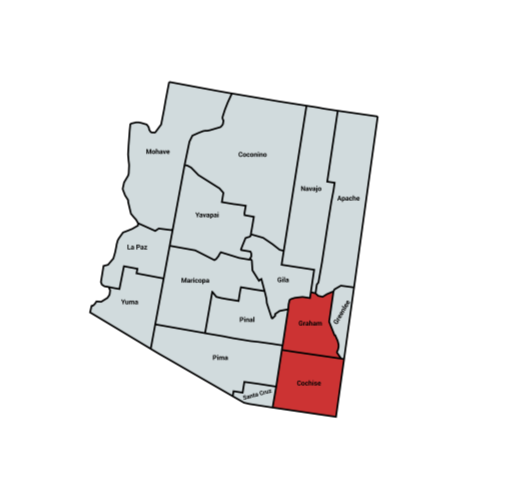
The Desert Massasauga rattlesnake lives in small areas in Cochise and Graham Counties in southeastern Arizona. Although isolated populations persist, their numbers are declining, making eventual extirpation likely. In Arizona, the Desert Massasauga is protected from collection and harassment.
How Dangerous Are Desert Massasauga Rattlesnakes?
The venom of the Massasauga rattlesnake is cytotoxic. Cytotoxic venom destroys body tissue. Moreover, digestive enzymes in cytotoxic venom disrupt blood flow and prevent clotting. Massasauga bites to humans are rare. However, they do occur.
There are two documented deaths in Ontario from Eastern Massasauga envenomations. In each case, the victim did not receive antivenom in time.
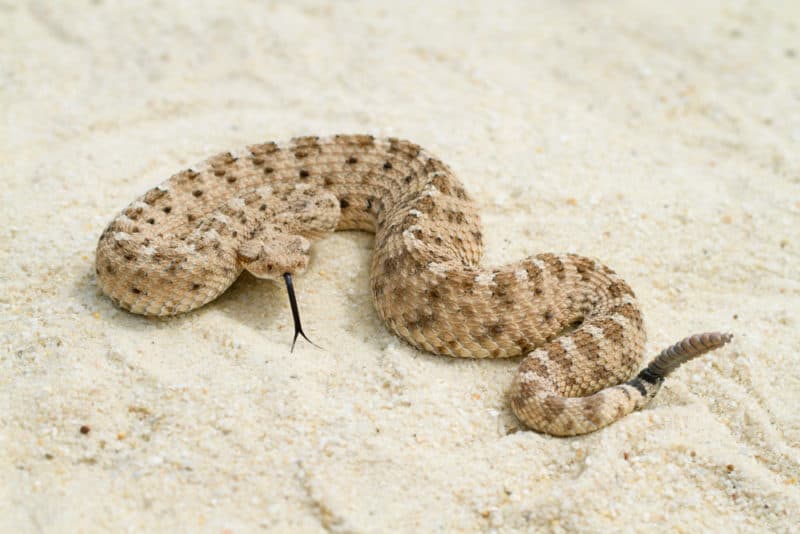
Sidewinder Rattlesnake (Crotalus cerastes)
The Sidewinder Rattlesnake is found in the southwestern United States and northwestern Mexico. In Arizona, they are found in the western part of the state.
What makes the sidewinder unique is how it moves. These snakes get their name for their peculiar sideways form of travel. They lead with their midsections instead of their heads. It turns out that this is a much more effective way to move across the sand. They are fast-moving snakes and can reach speeds of up to 18 mph.
| Size | *Adult sidewinder measures 17 to 31 inches in length. *Female sidewinders are the largest. |
| Coloration | *Their base color is cream, buff, yellowish-brown, pink, or ash gray. *The belly is white. *The adult’s proximal lobe’s rattle is brown. |
| Dorsal Spots | *Overlaid with 28 to 47 darker dorsal blotches. |
| Head | *They have two prominent “horns” above their eyes, aiding the sidewinder in thriving in sandy environments. |
| Unique Trait | *This species has a chameleon-like ability to change color, adapting to different surroundings. *The process of doing this is metachrosis. |
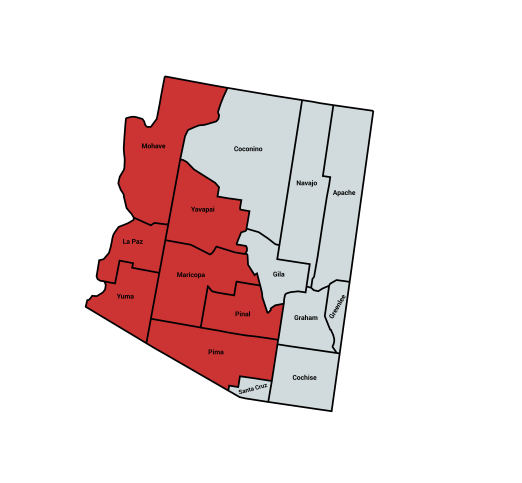
There are three subspecies of sidewinder rattlesnakes in Arizona:
- Mojave Desert Sidewinder (Crotalus c. cerastes)- These snakes are found in La Paz County, Arizona.
- Desert Sidewinder (Crotalus c. cercobombus)- These snakes are found in Maricopa, Pima, Pinal, and Yuma Counties in Arizona.
- Colorado Desert Sidewinder (Crotalus c. laterorepens)- These snakes are found in Pinal County, Arizona.
How Dangerous Are Sidewinders?
The Sidewinder rattlesnake is venomous, but its venom is weaker than other rattlesnakes. Their smaller venom glands make them less dangerous than their larger relatives. You should still be wary of them because any rattlesnake bite can be fatal. If bitten, you should seek medical attention immediately.
Sidewinders can’t inject enough venom in one bite to create severe complications. However, it’s more serious if the victim gets envenomated multiple times. If medical treatment is delayed, the following complications could occur.
- Internal bleeding
- Deep tissue damage may lead to bacterial infections and gangrene.
- Loss of use of the affected limb
- Severe shock
- Paralysis
- Seizures
- Coma
- Multiple organ failure
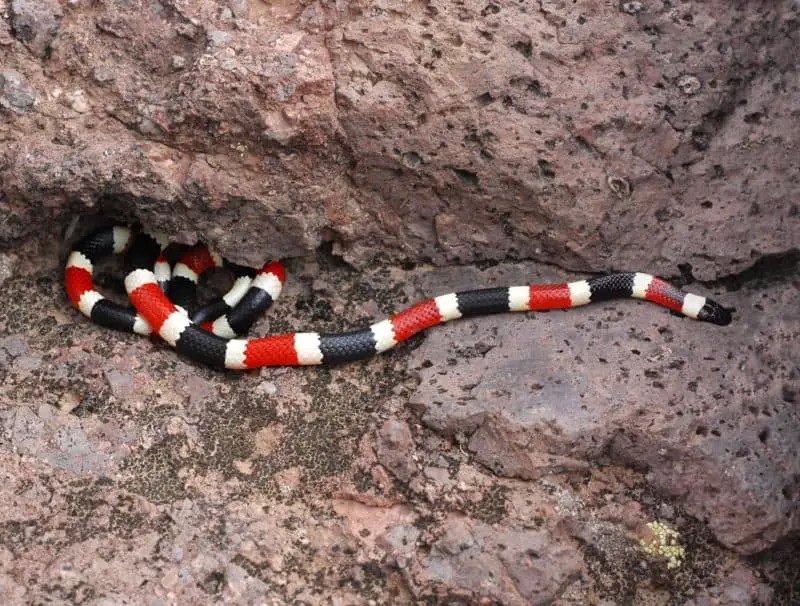
Arizona Coral Snake (Micruroides euryxanthus)
The Arizona Coral snake is also called the Western Coral snake or the Sonoran Coral snake.
What Do Arizona Coral Snakes Look Like?
| Size | *Rounded heads and noses, with tails that resemble the head. *This similarity can make distinguishing the head from the tail hard. |
| Physical Features | *Rounded heads and noses, with tails that resemble the head. *This similarity can make it hard to distinguish the head from the tail. |
| Coloration | *Brightly colored, highly venomous snake. *Bands of black, light yellow, and red. *Yellow bands separate the red and black bands. |
Where Are Arizona Coral Snakes Found in Arizona?
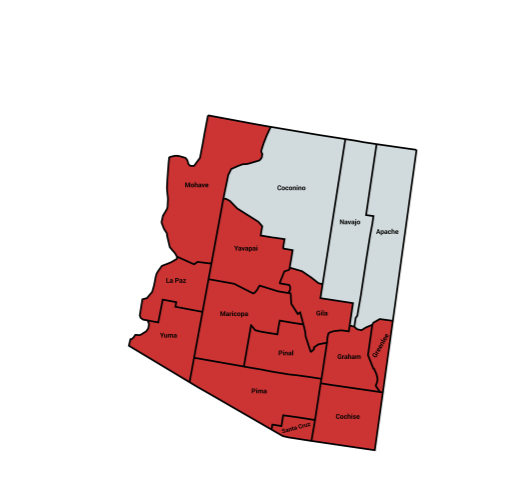
They are found in Central and Southern Arizona. Their range takes in desert planes and mountain slopes from 5,800 feet.
Batesian Mimicry Of Coral Snakes
Batesian mimicry is a biological term. It describes how a harmless species protects itself by resembling a dangerous one. For example, the desert kingsnake and the milk snake are nonvenomous snakes. However, their color patterns both closely resemble the venomous coral snake. The difference is that a coral snake’s red and yellow bands touch. On the other hand, the nonvenomous species’ color patterns are red, black, and yellow. Also, a coral snake’s head is blunt and entirely black, even behind its eyes, while a Kingsnake’s head is red.
This rhyme helps people distinguish between a nonvenomous species and a coral snake. “Red and yellow can kill a fellow; Red touch black, a friend of Jack.”
The rhyme is mostly accurate in the United States. However, coral snakes from areas south of the U. S. do not always follow the black-yellow-red pattern. This is also true in Central America, South America, and the Caribbean.
Finally, there are rare coral snakes that do not follow the usual color pattern in the United States. Pink, cream-colored, light blue, and completely black coral snakes exist in the wild.
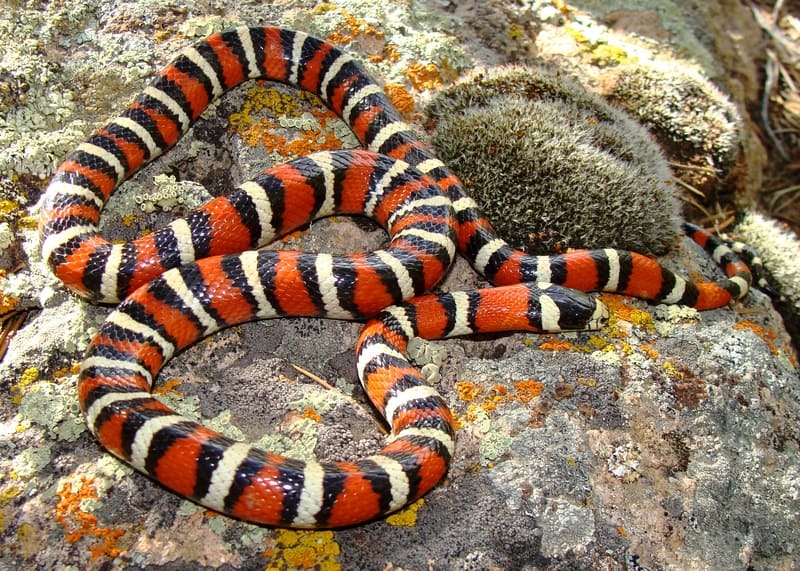

Arizona Coral Snake Behavior
Western Coral snakes are underground snakes. They spend most of their time buried in the sand, under leaf piles, and in rotten logs.
Defensive Farting
When rattlesnakes are uptight, they rattle their tails. On the other hand, coral snakes react to stress a bit differently.
When coral snakes are agitated, they fart. To do this, they draw air into their cloacas and force it out again. This makes a popping sound.
How Dangerous Are Western Coral Snakes?
Coral snakes have neurotoxic venom. It is the second most potent snake venom in the world. (The mamba being the most venomous).
However, they are considered less dangerous than rattlesnakes. The reason is that they have a less effective venom delivery system. Their smaller mouth and fangs produce less venom. Yet, a coral snake bite should be taken seriously, and medical treatment should be sought. Sometimes, the manifestation of a severe bite doesn’t present itself for 24 hours.
Arizona’s Rear-Fanged Colubrid Snakes
Colubrid snakes belong to the Colubridae family. Colubridae is the largest, most diverse snake family on earth. They are found on every continent except Antarctica. While most Colubrid snakes are non-venomous, some, such as the Boomslang, are highly venomous and extremely dangerous.
Arizona’s venomous Colubrid snakes are opisthoglyphous. Opisthoglyphs have grooved fangs at the back of their upper jaws. None of Arizona’s Colubrid snakes produce venom that is very dangerous to humans. However, any venom has the potential to cause a severe allergic reaction. It’s a good idea to consult a physician if you’ve been bitten by one of these snakes.
The following are the venomous colubrids that are found in Arizona.
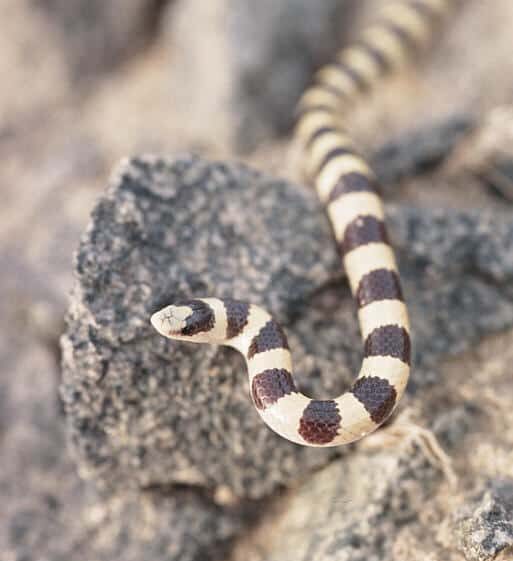
Western Shovel-nosed Snake (Sonora occipitalis)
| Size | *Western Shovel-nosed snake is small. *Grow around 12 to 17 inches (30.48 to 43.18 cm) in length. |
| Coloration | *Their snout is cream-colored. *On top of the head, between and posterior to the eyes, is a black crescent moon shape. *Their body is cream colored with blackish-brown bands. *The majority have interspersed reddish-orange bands that don’t circle their body |
| Venom | *The venom of the Western Shovel-nosed snake is not usually dangerous to humans. |
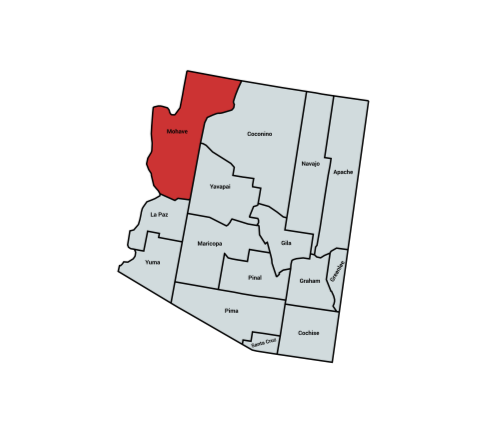
These snakes are found in the western sandy deserts of Arizona.
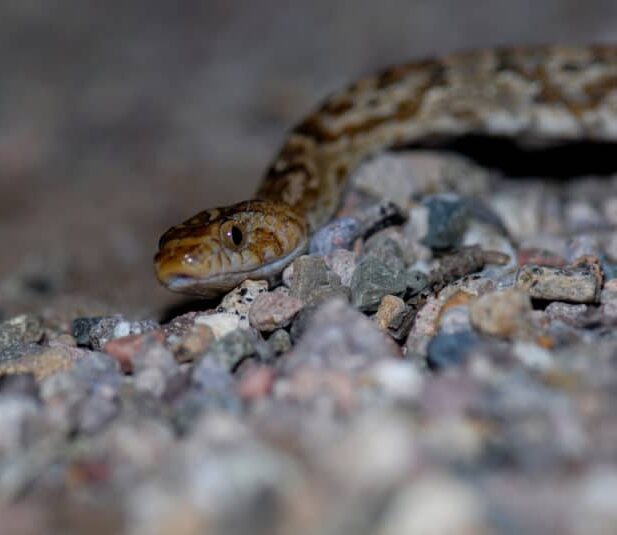
Sonoran Lyre Snake (Trimorphodon lambda)
| Size | *The Sonoran Lyre snake is a thin snake. *They can get up to 4 feet (121.92cm) long. |
| Coloration | *They have a light brown-colored body. *Dark brown saddle markings on top. *Their belly is a creamy white color scattered with brown spots. |
| Unique Markings | *The Sonoran Lyre Snake gets its name from the markings on its head that resemble a lyre harp. *This marking is more prominent in females. *They look similar to a king snake until you notice the narrow neck, making its head appear triangular. *Their pupils are vertical slits like other venomous snakes rather than round. |
| Venom | *This snake is mildly venomous but not considered dangerous. |

They are found in the desert regions of southern Arizona. They are rarely seen because they are nocturnal.
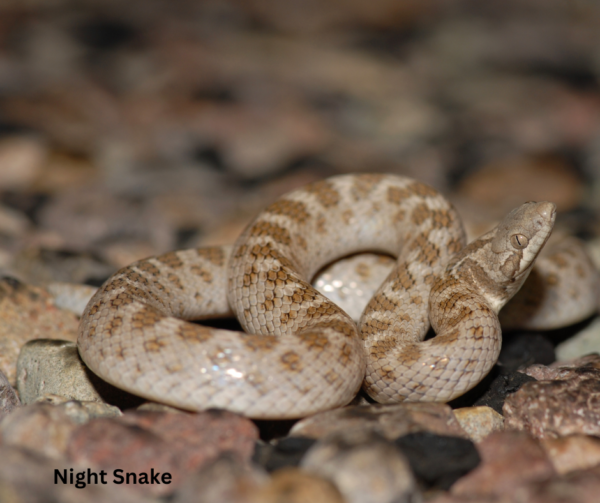
Night Snake (Hypsiglena torquata)
| Size | It grows from 12 to 26 inches (30.48 to 66cm) long. |
| Coloration | *Base color is a light beige to pale gray color. *Dark gray or brown blotches on its sides and back. *It also has a pair of dark blotches on the neck. *Its belly is a whitish color. |
| Head | *Its head is flat and triangular-shaped. *A dark brown bar runs behind its eyes. |
| Venom | *The Night snake is slightly venomous but is no threat to humans. |
It is found in most parts of Arizona.
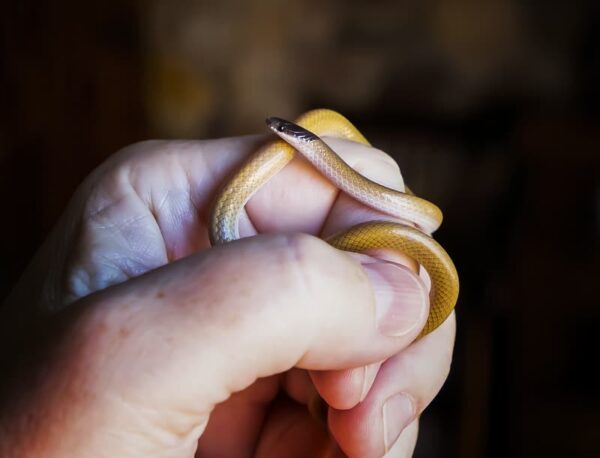
Southwestern Blackhead Snake (Tantilla hobartsmithi)
| Size | *The Southwestern Blackhead snake is tiny. *Adults are 8 to 15 inches (20 to 38cm) long. |
| Coloration | * Body is brown with a black-colored head * A reddish stripe runs down the center of there cream colored bellies. |

This snake lives across southeastern Arizona. They also range in Central Arizona below the Mogollon Rim.
Southwestern Blackhead snakes are nocturnal. They spend most of their time hiding in loose soil or underground debris. These are rear-fanged snakes whose venom is harmless to humans.
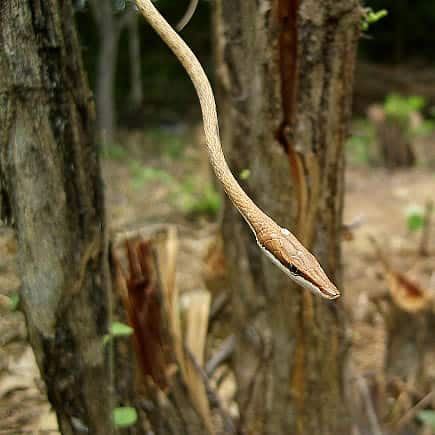
Pike-headed Tree Snake (Oxybelis aeneus)
Other names for this snake are Brown Vine snake or Mexican Vine snake. In Arizona, it is known as the Pike-headed Tree snake.
| Size | *It is an extremely slender snake. *Adults reaches up to 6 feet (183 cm)in length. |
| Coloration | *Base color varies from brown to gray *Bellies are a yellowish color. |
| Head | *Their heads are narrow with a long snout. |

Their bite can cause an itching sensation. Although they are mildly venomous, this rear-fanged snake is not dangerous to humans.
Avoiding Snake Bite in Arizona
Many bites happen when someone accidentally steps on or near the snake. To stay safe in snake habitats, always watch where you step and where you place your hands.
Another common cause of snake bite is attempts to capture or kill a snake. Remember, venomous snakes can strike instantly, delivering a potentially life-threatening bite. The safest approach is to keep a safe distance and leave them alone.
Dressing for Snake Country
- High-top leather boots and long pants are both wise ideas.
- Also, wear loose-fitting denim. If there’s a gap before the snake’s fangs touch your skin, your chances of being envenomated are lower.
- In the absence of high-top leather boots, some people wear snake gaiters.
Symptoms of Venomous Snake Bites
Some of the symptoms you may experience from a venomous snake bite include:
- Discoloration in the area of the bite.
- Swelling in the area of the bite.
- Loss of muscle coordination.
- Tingling sensation in the area of the bite.
- Feeling nauseous.
- Having an abnormally rapid pulse.
What Should You Do If A Venomous Snake Bites You?
If you or someone you are with has suffered a venomous snakebite, time is of the essence. This is because the sooner a victim receives anti-venom, the less likely the venom in their body is to cause harm. In other words, it is important to seek immediate medical attention.
Do not attempt to kill the snake for identification purposes. This gives the snake a chance to bite you again. Also, consider that severed snakeheads can still bite and envenomate. If you have a phone, take a picture of the offending reptile. Otherwise, get started on your way to the doctor.
First Aid for Snake Bite Victims
- Remain calm and limit your movements. Do not run. If you must hike back to a vehicle, do it calmly and deliberately. Put as little stress on your heart as possible.
- Keep the area of the snake bite below the heart level and never above the heart level. Keeping the bite below the heart level will reduce the venom’s flow. However, holding the bite above your heart level will increase the venom’s flow.
- Remove all constricting items such as bracelets, watches, or rings before swelling occurs.
- Remember that using a cold compress on a venomous snake bite is not advisable. The cold may cause the local blood vessels to constrict and spread the venom faster.
- You can wash the affected area like any other wound with soap and water.
- You may cover the bite area with a moist dressing to reduce the swelling.
- Get medical attention as soon as possible. Call the hospital to tell them a venomous snake has bitten you. So they can have anti-venom ready to give you when you arrive.
- A person whom a venomous snake has bitten may go into shock. If this happens, lay them flat and cover them with a blanket.
Conclusion
Arizona has a wide variety of venomous snakes. There are 17 rattlesnake species in Arizona, as well as a species of coral snake. The state is also home to 5 different venomous colubrid snakes. Each of them has a crucial role in the state’s ecosystems. While the presence of some of these snakes can be intimidating and potentially dangerous, understanding their habitats, behaviors, and identifying characteristics is key to safely coexisting with them.
Residents and visitors can greatly reduce the risk of venomous bites by respecting these snakes and exercising caution, such as wearing protective gear in snake-prone areas and avoiding unnecessary interactions.
Recent Posts
The only venomous snakes in Washington State are Northern Pacific Rattlesnakes. The Northern Pacific Rattlesnake (Crotalus oreganus oreganus) is a sub-species of the Western Rattlesnake. Anyone...
Skunks are not classified as true hibernators. But they go into a state of torpor when the weather gets cold. Skunks are light sleep hibernators, along with opossums, bears, and raccoons. ...
